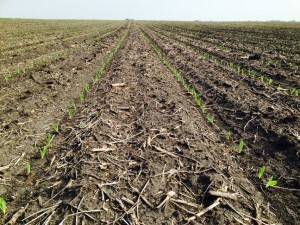It Pays to Watch Crops Pop Up in Rows
 There are more than 1,000 variables that can affect crop development throughout the growing season. Soil conditions, planter settings, seed spacing and seed planting depth are of utmost importance at the time the crop goes into the ground.
There are more than 1,000 variables that can affect crop development throughout the growing season. Soil conditions, planter settings, seed spacing and seed planting depth are of utmost importance at the time the crop goes into the ground.
Frequent rain showers delayed planting longer than farmers across the Upper Midwest would like. Some are feeling additional pressure to get the seed in the ground as fast as possible. Keep in mind that haste makes waste! Take the time to:
- Verify correct depth and kernel spacing at planting time.
- Check germination and early seedling growth for problems.
- Assess early emergence scores for adequate final stand numbers if soil conditions weren’t ideal.
Also keep in mind that spring rains might have created crusting issues in some of the earlier planted fields, especially in fields without residue. To help break up the crust and improve seedling emergence, many farmers will use a rotary hoe.
If you decide to till the soil, wait until soils have dried to avoid exacerbating the situation with soil compaction. Use a quick field test to check soil moisture.
Starting with clean fields, and keeping the fields clean, is most important. A pre-plant or pre-emerge herbicide application:
- Aids in controlling resistant or tolerant weeds.
- Helps keep the field clean all season long.
- Helps your crops reach their maximum yield potential as they’re not competing with weeds for water, sunlight and nutrients.
Once plants have emerged, it’s time to:
- Identify any early season stresses on young plants.
- Look at plants’ visual appearance for nitrogen or other nutrient deficiencies.
- Look for weed escapes. Make a plan for a season long weed-free field!
Watch for additional agronomic tips and tricks to be shared each Tuesday & Thursday during the growing season on TheFieldPosition.com
